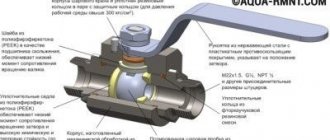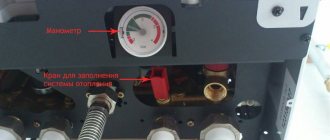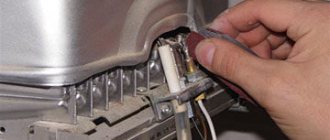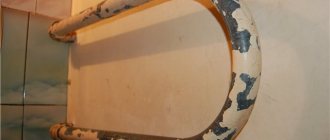Owners of heated towel rails from time to time face such a problem as leaking. Very often this problem occurs precisely at the junction points. If you notice that the joint is constantly wet and dripping, you definitely need to turn off the water! If your heated towel rail has a bypass installed, all you need to do is turn the tap handle. This needs to be done as soon as possible, since the pressure drop inside the pipes can further worsen the situation and the towel dryer may simply break. It is not always possible to immediately address the leak and eliminate it. Therefore, if you do not have time to carry out repairs, remove the dryer and put special plugs on the pipes.
Bathroom heated towel rail
Old model and reasons for its breakdown
If a heated towel rail that was installed many years ago is leaking, you need to act quickly so that the problem does not become global, because the time of operation leaves its mark on the condition of the structure.
If after inspection it is discovered that the heated towel rail is covered with rust at the connection point or on the surface of the pipes, it is recommended to replace the entire structure or its individual parts. You cannot simply ignore the manifestation of corrosion. Otherwise, the slightest fluctuation in pressure in the system will provoke a breakthrough and, as a result, the loss of the bathroom. For the safety of the old model, hydraulic protection is installed at its inlet.
- When dents are found on a heated towel rail, it is recommended to think about replacing the structure or partial repair. In most cases, mechanical damage to the old model is the cause of the leak in this place. Moreover, the crack grows quickly due to wear and tear of the structure. If the problem arose after the work of the repair team, then the team must dismantle the old heated towel rail and install a new one.
- Gaskets are installed at the joints and lubricated with sealant. Over time, they become deformed and dry out. This is the reason why the heated towel rail leaks. The water supply in the riser is shut off, the gaskets are changed and re-lubricated with silicone sealant.
Problem areas mostly arise from the fact that the model has already worn out and lost its strength. Small cracks quickly develop into holes with large leaks. Therefore, repairs in this case are sometimes more expensive than replacing with a new model.
Which heated towel rail doesn't leak?
No matter how sad it may be, when a heated towel rail leaks, in some cases it needs to be completely replaced. Of course, replacing bathroom equipment requires money, and every time people buy a new dryer, they give their money in the hope that this one will definitely not leak. But the problem happens again. And then the question arises: “Is there a heated towel rail that doesn’t leak?” Of course there is!
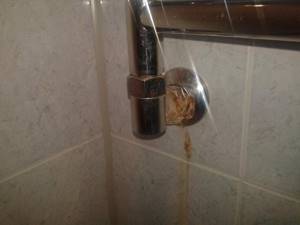
Corrosion on the heated towel rail
A heated towel rail with no water will never leak. So, if you are tired of water appliances, you can easily replace the water heated towel rail with an electric one, and it will certainly never leak. Electric models have many advantages:
- The very first and most important of them is that an electric heated towel rail never leaks!
- It is also independent of system pressure and hot water supply.
- Installing and maintaining the electric model is quite simple.
- You can control the heating temperature of the dryer yourself.
- If you have nothing to dry, you simply turn off the heated towel rail and it does not consume electricity.
It’s safe to say that electric models will be able to replace water heated towel rails and will fit well into bathrooms. But electric models also have some disadvantages. The most significant of them is the use of electrical equipment in conditions of high humidity. What to do in this case? Is it really possible that the only dryer that doesn’t leak can’t be installed in the bathroom? Of course you can! But this must be done by a professional! Professionally performed work will allow you to avoid electric shock.

An electric heated towel rail will save you from headaches about leaks.
Necessary knowledge for self-repair
Improper installation of supply pipes can create conditions for leaks. This kind of problem is difficult to fix on your own. If the hot water supply pipes are installed crookedly, the risk of leakage increases. Carrying out repair work can have a short-term positive effect. In this case, it is advisable to install a device for tightly closing the pipes and install an electric heated towel rail.
To fix an existing leak, it is important to understand how plumbing is installed. If a person has not previously had such experience, it is better to leave the work to professionals.
There are a number of rules that must be taken into account when performing repairs.
Hot water circulates in the coil. It should be covered first. If the fluid supply is turned off, repairs cannot be started immediately. You should wait until the device cools down. You need to prepare a bucket and a rag in advance to drain the water. Only after this can you begin to eliminate the existing defect.
conclusions
To avoid leaks, as well as frequent breakdowns of the heated towel rail, it is necessary to handle repair work responsibly. If you don’t know how to cope with a particular task, there is no need to improvise; it is better to invite a specialist who will tell you how to cope with this or that task. When a professional does the work, the risk of leakage is significantly reduced, and heated towel rails serve their owners for a very long time.
We wish you that your heated towel rails rarely fail, and that the breakdowns are completely insignificant.
Methods for eliminating leaks
About half of the problems listed can be solved on your own. Issues that cannot be resolved on your own are usually resolved by replacing the heated towel rail. The first action after discovering the network is to call the housing office to turn off the riser of the entire entrance. You will then have a day to fix the leak yourself or call emergency services. The service of disconnecting the riser is paid.
It’s a little easier if the installation includes a bypass line, which is also called a bypass line. The bypass line is a jumper between the supply and return pipes with shut-off valves. If necessary, the bypass valve opens and water begins to flow along the path of least resistance, that is, along the bypass line. This allows you to avoid problems with disconnecting the entire entrance from hot water.
Let's look at ways to eliminate leakage separately for each problem:
Burst pipes. Any hole in a pipe can always be welded. Only if it's not copper or brass. Stainless steel is easy to weld. But you need to take into account that you can only weld a hole close to the connection points. Clothes will catch on the welded seam in the middle of the heated towel rail, which can cause stretch marks to remain on the fabric. In addition, it will look extremely unaesthetic. Corrosion holes can only be solved by replacing the entire heated towel rail. The appearance of such leaks means that the device has failed due to long-term use. The same applies to pipes that are overgrown from the inside. Rubber gaskets. If you are sure that the gaskets are leaky, then you just need to replace them. The seals themselves are inexpensive; the bigger problem will be to disconnect the heated towel rail from the network. During the replacement process, it is tedious to use sealant. Leaks at the points where the pipe connects to the network are eliminated by tightening the nut or sealing the connection. For sealing, linen thread and gel sealant are used. A leak in an incorrectly connected device can be resolved by reconnecting using a level.
It is important to route the pipes straight so that the problem does not arise again. It is logical to assume that the problem with the wrong choice of device can be corrected only by purchasing a new heated towel rail.
If the cause of the leak is in the gaskets, they should be replaced
Sealing at joints
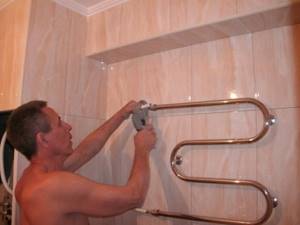
Leaks of the device are often observed if, during the installation process, the connecting elements were not tightened securely enough or there is not enough winding in such areas. Fixing problems in threaded connections will require unscrewing the fittings, as well as using flax and plumbing paste.
The Unipack composition, designed to operate under temperature conditions within 140°C, has proven itself very well. This paste, in combination with flax fibers, provides excellent tightness and also allows for convenient adjustment during the assembly of any joints. Before winding, the threads are thoroughly cleaned of dirt and dust. A layer of paste is evenly applied over the flax, after which the elements are assembled and the fittings are tightly tightened. At the final stage of repair, the heated towel rail is connected and tested for leaks.
The method for eliminating heated towel rail leaks should be chosen depending on the location of the leak and its level of complexity. However, in some cases, the best option would be to completely replace such an emergency device that has become unusable with a new and high-quality device for drying towels.
Which of the persistent problems can be eliminated with your own hands and what to do if an American leak is occurring?
In case of metal corrosion, water hammer, incorrect battery installation or manufacturing defects, you should contact a specialist. But most problems with water leakage at the junction of the main pipe and heated towel rail can be solved independently by first turning off the water supply. For example:
- If there is a slight leak at the connection points under the union nut, then the cause may be a weakening of the American one - you need to carefully tighten (but not overtighten, so as not to damage the thread) the nut with a suitable wrench.
- If the leakage cannot be eliminated, unscrew the American connection and check the rubber gasket. If necessary, replace the worn part with a new one.
- If you don’t have a gasket or a piece of rubber on hand from which you can cut a suitable part, wrap a piece of linen fabric around the thread, apply sealant on top and let it dry. Then screw the clamping nut into place.
- If the cause of water leakage is steel wear (at the welding joints of the heated towel rail or in the pipe itself), a “clamp” made from a suitable piece of metal will be a temporary solution to this problem. After installing the “clamp,” it must be welded.
Important! Before starting work, you need to warn the neighbors below about possible unforeseen situations (if you fail to fix the leak yourself, you can break the thread of the nut or damage the pipe) and turn off the water supply in the apartment
Eliminating leaks for different types of connections
In case of complete or partial replacement, you should purchase individual elements or a new device, the installation of which is recommended to be entrusted to professionals.
The person who caused the harm is released from compensation for harm if he proves that the harm was not caused through his fault.
A heated towel rail in our apartment burst (a fistula formed in the radiator) while we were not at home. As a result, 4 floors were flooded. Imagine, God forbid, a joint leaks, you won’t even be able to close anything, and the water there is hot. This year we collided. Our crane simply saved us.
Radiator leak
Hot water appears thanks to the existing heat exchanger. The heat exchanger radiator consists of metal pipes and plates located close to each other. The plates come into direct contact with the fire, due to which soot appears on them during operation.
Signs of soot accumulation include:
- The flame is yellow;
- When burning, the fire deviates to the side and heats the body (the flame should tend upward);
- Soot falls off the gas water heater;
- Even when operating at full power, the water heats up weakly.
To remove soot, you will need to remove the casing by unscrewing the bolts (latches) that secure it.
After the assembly is removed, it must be washed by placing it in a container with water for several hours to loosen the soot. This will make it easier to clean the space between the heat exchanger plates. For quality cleaning, it is recommended to use running water, a long-bristled brush and detergents. After drying, the radiator is put in place.
Green spots on the heat exchanger indicate existing cracks and holes.
If the geyser is leaking due to a failure of the heat exchanger radiator, then the actions should be as follows:
- The water supply pipes must be shut off to prevent water from entering the gas water heater. After which the hoses are disconnected and the remaining water is drained. The remaining liquid in the coil is removed with a pump or vacuum cleaner; you can try blowing the water out with your mouth using a hose. This must be done, since the remaining moisture absorbs heat during the soldering process, and it will not be possible to heat the metal to the desired temperature.
- Damaged areas (they are green) will need to be cleaned with sandpaper and degreased with a solvent, and then wiped dry.
- Crushed rosin or an aspirin tablet should be sprinkled on the work surface. Rosin and aspirin will serve as solder here.
- Using a soldering iron with a power of at least 100 W (since they will have to work at temperatures above 180 degrees), it is necessary to increase the solder to a height of approximately two millimeters. If the soldering is loose, this means that the working surface is not heated enough. You can additionally heat the soldering area with an iron or another soldering iron.
- Each through-hole fault will need to be soldered in a similar manner.
- After the soldering work is completed, you need to wait until the working surface has completely cooled and assemble the gas water heater.
- Before full operation, the equipment is started in test mode.
If the geyser is leaking, but no leaks are visible on the radiator, then perhaps they are located where it is turned towards the body. In this case, you will need to remove the heat exchanger from the housing, which will require disassembling the entire column. Before starting the procedure, it is advisable to familiarize yourself with the diagram in the passport, since this is a rather labor-intensive process and knowledge of the structure of a specific model will simplify the work.
Soldering damage to pipes can only be used as a temporary measure to eliminate the reason why the geyser is leaking, since the repaired surface remains vulnerable. The best option for troubleshooting problems that result in water dripping from the column is to replace worn elements with new ones.
The heated towel rail is leaking at the welding points, three units were replaced and the result was the same.
The third option is also good, the only obstacle is the hot water in the heated towel rail, which is an obstacle. In addition, in order to seal the area of damage (rust and leaks), it must be thoroughly cleaned, otherwise a positive effect is unlikely to be achieved. The use of a cement bandage to seal a heating pipeline is a temporary measure, since cement is not plastic and does not easily resist the tensile forces that will affect it during thermal expansion of the pipes, so even reinforcement with sickle tape will not save you from the occurrence of microcracks in the repair casing over time.
How to understand that there are stray currents? You may notice rust spots on the surface of the coil. First - if you look closely, then - with the naked eye. The dots gradually become larger, and eventually form cracks through which water leaks. Stray currents “eat up” the pipes.
These processes occur due to the electrolysis process, since an electric current of even low power, passing through tap water highly saturated with salts, causes this process, as a result of which the metal begins to gradually oxidize and become corroded.
Corrosive plaque can form both on the internal walls of the heated towel rail and on the outside. The location of rust and the degree of damage to the pipe determines the cleaning method. How to remove rust from the outer surface of the dryer?
If you take the necessary and individual measures in time, this will not lead to water leakage.
Moreover, these plastic pipes, coupled with the chrome heated towel rail, look simply pathetic! And these couplings are huge...
It is better to connect such a device through the bypass line using an American type mount. This mount is more mobile than others, meaning it allows you to easily replace the heated towel rail.
Then another layer of overlapping mesh turns is applied to the pipe, and the cells are again filled with soda. After laying the third layer of serpyanka with soda, the last turn of the tape is secured with a nylon clamp, and glue from a tube is applied to the resulting coupling, starting from the site of damage. The glue is instantly absorbed into the soda and, reacting with it, also instantly hardens, forming a durable shell.
Please note: each bath must be grounded (to the pipeline) with a separate conductor, because otherwise it has no electrical connection to the grounded water pipe.
If the size of the resulting crack is small, then it is not necessary to replace the entire pipe. You can try sealing it with silicone sealant first, especially if we are talking about permanent damage. Most often, sewer systems are repaired in this way. But in practice it happens differently. In some places, the welded joint is replaced with bends and additional resistance is introduced, and in others, pipes made of plastic or propylene are inserted, breaking the metal connection between the riser pipes and the metal heated towel rail.
First, it’s worth considering the types of heated towel rails. Not every dryer can leak. Therefore, it is better to install dryers in apartments that cannot leak in principle. This will save you from many problems in the future.
In some cases, it is advisable to completely replace a rusted device with a new heated towel rail of the “Lesenka” model, which in most cases are equipped with special protection against electrochemical corrosion.
There are several possible reasons for leaking heated towel rails, and not all of them are related to defects or mechanical damage. Most often, the malfunction is associated with long-term operation of the device, which is accompanied by a noticeable weakening of some connecting elements, wear of the spacer rings, or corrosive changes.
Possible causes of heated towel rail leaks
Heated towel rail installation diagram.
Not only an old model can leak, but also a completely new one that has just been installed. The reasons why a heated towel rail is leaking can be completely different in both cases. To reduce the creation of an emergency situation or avoid it, it is necessary to promptly identify a possible danger and, most importantly, eliminate it. The reasons why the heated towel rail began to leak apply to all types of models: plumbing, electric and combined.
An old heated towel rail leaks under the following circumstances:
- Damage at the connection between the device and the main pipeline or the beginning of corrosion of the pipe body can cause the heated towel rail to leak. Most often, in this case, there is a constant leakage, which can be easily detected with subsequent replacement of the system. But this requires periodic preventive inspection of the entire device.
- Water hammer or a sharp increase in pressure inside the system. To prevent this phenomenon, it is recommended to install a hydraulic protection system at the water supply inlet.
- Mechanical damage to the device by a third-party object, which was not immediately detected. Most often, such accidental damage occurs during repairs. Therefore, after completing all repairs and other work, it is recommended to check, including the bathroom, whether the heating system is leaking anywhere or whether it has suffered mechanical damage.
- Wear at sealing areas. Usually the installation in this case is gradual, but as soon as this is discovered, the entire seal should be replaced.
Bends for heated towel rails.
A new heated towel rail leaks under the following circumstances:
- The qualitative characteristics of the device absolutely do not coincide with the parameters of the installed heating system. In this case, the heated towel rail definitely needs to be replaced, and as quickly as possible.
- Poor quality installation work. After completing all installation work, it is necessary to regularly carry out preventive inspections at the connection points of the device. If moisture is detected, it means that the system is leaking somewhere, then you need to seek help from a specialist or fix the problem yourself.
- The product has a manufacturing defect. Here, potential consumers are advised to take the choice of installation seriously and purchase products that have a certificate of quality and warranty. And if you find the slightest malfunction, contact the seller to replace the defective device.
What can affect the leak?
It is very important to understand that the formation of a leak is affected not only by the material from which the heated towel rail is made, but also by the water in it. The quality of water currently used in all water supply systems leaves much to be desired. Only models made of stainless steel can resist its corrosive action and corrosion. However, when choosing a steel heated towel rail, you need to be extremely careful. Stainless steel models are quite popular nowadays and this leads to the fact that they are more often counterfeited than others. In order not to buy a fake or defective dryer, you must carefully inspect your future purchase and also ask for a quality certificate.
People who have country houses very often buy heated towel rails made of ferrous metals. Such products look quite beautiful. They will serve you faithfully for many years only if your bathroom has good ventilation and a well-equipped heating system. In an ordinary apartment in a multi-storey building, heated towel rails made of ferrous metal do not take root for long. They corrode and become clogged with small particles of sand, salt, as well as other micro-objects and impurities found in the coolant.
That is why it is very important to know what material your heated towel rail is made of and how long this material will be able to serve you under similar conditions and irritants.
Appliance repair
- If the heated towel rail stops heating as a result of a clogged electrical connection, you must first unplug it and then remove it from the wall. Then unscrew the valve and clean it using the most ordinary metal wire. Next you need to perform the same procedure from the end of the structure. Then return the valve to its original place and check the operation of the device. If everything is fine and the heated towel rail starts to heat up as before, you can begin installing it on the wall.
- If the heated towel rail does not heat as a result of clogged pipes of the water appliance, you must first turn off the tap at the connection point and remove this equipment from the wall. Then you need to drain the remaining water inside the device into a prepared container. To do this as quickly as possible, you need to unscrew all the existing fittings. Next, you need to take a metal cable and thoroughly clean all the channels of the heated towel rail. Then shake the device a little, knocking off any remaining debris from its walls, remove it from the equipment and rinse thoroughly under running water. It is advisable to repeat this procedure 2-3 times to make cleaning more effective. You can remove hard deposits using hydrochloric acid. To do this, you need to pour it inside for 10 minutes.
- If the heated towel rail does not heat due to the formation of an air lock, to eliminate it, you must open the valve and release all the air from the device. To find the required crane, you must partially dismantle the structure. There will be a bolt located above the tap that will allow air to bleed. You can unscrew it using a minus screwdriver. You need to use it to pick up the hardware and unscrew it a little (half a turn). This will allow any trapped air to escape. Once it is completely deflated, water will start flowing from the valve. After this, tighten the bolt, close the valve and put the structure in its place.
Basic set of tools for repairing leaks
You can repair a leaking coil yourself, but this will require a number of tools and materials, including:
- adjustable wrench;
- sealant;
- tow;
- gaskets that fit;
- scissors;
- set of open-end wrenches.
If the problem lies in damage to the heated towel rail due to corrosion or a manufacturing defect, then a welding machine should be used when carrying out repair work. You need to prepare a bucket or basin in advance to drain water from the device. You will also need a rag or towel.
Repairing a heated towel rail with a leak from under the nut
Most often, a heated towel rail begins to leak at the place where the nut is fixed. Fixing this problem has some features. First, inspect the union nut area. It can weaken due to temperature changes. In this case, it needs to be tightened with an adjustable or open-end wrench.
If tightening does not eliminate the leak, the gasket needs to be replaced. To carry out this work, you must first turn off the water supply and wait until the device cools down. Then unscrew the union nut with an adjustable wrench and drain the liquid into the prepared bucket. The old gasket must be removed and a new one installed in its place. A small amount of tow, lubricated with sealant, is wound onto the pipe threads.
If a perforated corrosion center has formed in the area where the nut is fixed, applying a clamp will eliminate the leak. It is not recommended to use welding to close a defect, because This will weaken the pipe, which can cause it to burst and flood the bathroom. However, it should be taken into account that even installing a clamp gives only a short-term effect and the leak will appear again after a while. The best solution would be to replace the underwater pipes and heated towel rail.
In some cases, these repair methods do not help eliminate the problem in the long term. A malfunction may occur due to a violation of the angle of the pipes during their installation and improper installation of the device. There is a high probability of a large gap appearing between the first and second.
In this case, the union nut cannot be installed correctly. Even if you manage to tighten it, the effect will be temporary. The pipes and fixture must be re-positioned and aligned. Because The amount of work is large; it is difficult for a person who does not have the necessary skills and knowledge to eliminate the malfunction. In such a situation, it is better to call specialists.
The heated towel rail is leaking, what should I do?
You notice that your heated towel rail is leaking . Something needs to be done, as the women say.
Do I need to turn off the water?
Situation 1. It is definitely necessary if water flows out in significant volumes and there is a serious risk of flooding your bathroom, apartment and neighbors below. We are looking for a couple of containers and organizing duty to drain the water in a timely manner, while we ourselves run (call) to the housing office and insistently demand that the water be turned off. To be convincing, you can promise a lot - you don’t have to choose, repairing the neighbor’s apartment will be more expensive.
How to fix a leak in a heated towel rail?
When a person purchases a heated towel rail, it may not always be of high quality. On the outside, they are all attractive and, at first glance, good. But there are manufacturers who sell defective towels. As a result of this, unpleasant situations happen.
Some time after installation in the bathroom, the towel begins to leak. When the water starts, high pressure is created, which finds a weak point, the thin wall of the towel, and squeezes out a small hole in this place through which water oozes out.
You can fix any leak using a clamp, but to do this you first need to shut off the water supply to the towel.
How to bleed air from a heated towel rail
Usually, before water is introduced into the hot water supply system, air accumulates in it. Accordingly, it ends up in the water supply systems of multi-storey buildings.
The heated towel rail is leaking - What to do?
A heated towel rail in the bathroom performs two functions at once: it heats the room and dries the bath towels laid out on it (hence its name).
- Main causes of leakage
- Repairing the leak
In essence, it is a serpentine-shaped radiator pipe connected to the riser of a heating or hot water supply system.
It often happens that due to thermal expansion during operation, under the influence of increased pressure and corrosion, a heated towel rail leaks.
What to do in this case? How to eliminate a leak? First things first.
Nikiforov A. A asks a question:
How to fix a leak in a heated towel rail yourself, what materials are needed? What can be done most effectively?
Our expert answers:
It should be understood that now there are many types of heated towel rails, which differ in design and principle of operation. It can be:
- water;
- combined;
- electric.
There are various forms of the device:
- ladder;
- snake;
- lattice and others.
There are seamless models and with a seam. Therefore, each type requires a different approach.
But it doesn’t depend at all on the type how reliable and durable they are; such a nuisance can happen with the newest and most durable devices.
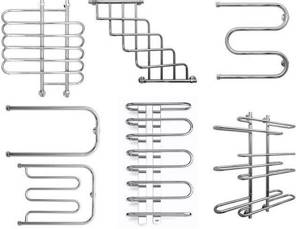
Types of heated towel rails
